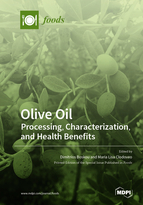Olive Oil: Processing, Characterization, and Health Benefits
A special issue of Foods (ISSN 2304-8158). This special issue belongs to the section "Food Nutrition".
Deadline for manuscript submissions: closed (31 December 2018) | Viewed by 59969
Special Issue Editors
Interests: natural antioxidants; olive oil composition; quality; bioactive constituents; health properties and culinary uses; table olives
Interests: emerging food technologies; food process scale-up; functional foods; food by-product; sustainability; circular economy; unitary operations of the gastronomic sciences
Special Issues, Collections and Topics in MDPI journals
Special Issue Information
Dear Colleagues,
Virgin olive oil is a vegetable, edible oil made from healthy and intact fruits of the olive tree, only by mechanical means such as crushing, malaxation and centrifugation. It is used without refining and keeps its unique sensory characteristics and biological properties. The oil has a health nimbus as a basic ingredient of the Mediterranean diet, but its positive role in health is now a topic of universal concern and the oil has become an agricultural product of paramount reputation. The benefits of the consumption of olive oil are due to its fatty acid composition and the presence of bioactive compounds, mainly phenols and squalene. These features justify existing recommendations and approved health claims related to protection of blood lipids from oxidative stress and coronary heart disease. New evidence, however, emerging from a better understanding of the chemistry of olive oil minor constituents relates these constituents to lower levels of systematic inflammation, and certain types of cancer and diabetes; these constituents may also have an effect on cognition. In light of these findings, new proposals should appear to modify and improve the technology of production to avoid significant losses of bioactive components due to processing, storage and packaging. Innovative approaches for quality and authenticity and properly designed human studies are a prerequisite for understanding better the health benefits of olive oil. Studies focusing on cellular and molecular effects of bioactive compounds are also a challenge.
Prof. Dimitrios Boskou
Dr. Maria Lisa Clodoveo
Guest Editors
Manuscript Submission Information
Manuscripts should be submitted online at www.mdpi.com by registering and logging in to this website. Once you are registered, click here to go to the submission form. Manuscripts can be submitted until the deadline. All submissions that pass pre-check are peer-reviewed. Accepted papers will be published continuously in the journal (as soon as accepted) and will be listed together on the special issue website. Research articles, review articles as well as short communications are invited. For planned papers, a title and short abstract (about 100 words) can be sent to the Editorial Office for announcement on this website.
Submitted manuscripts should not have been published previously, nor be under consideration for publication elsewhere (except conference proceedings papers). All manuscripts are thoroughly refereed through a single-blind peer-review process. A guide for authors and other relevant information for submission of manuscripts is available on the Instructions for Authors page. Foods is an international peer-reviewed open access semimonthly journal published by MDPI.
Please visit the Instructions for Authors page before submitting a manuscript. The Article Processing Charge (APC) for publication in this open access journal is 2900 CHF (Swiss Francs). Submitted papers should be well formatted and use good English. Authors may use MDPI's English editing service prior to publication or during author revisions.
Keywords
- Olive Oil
- Production technology
- quality
- authenticity
- bioactive constituents
- Mediterranean diet
- health







